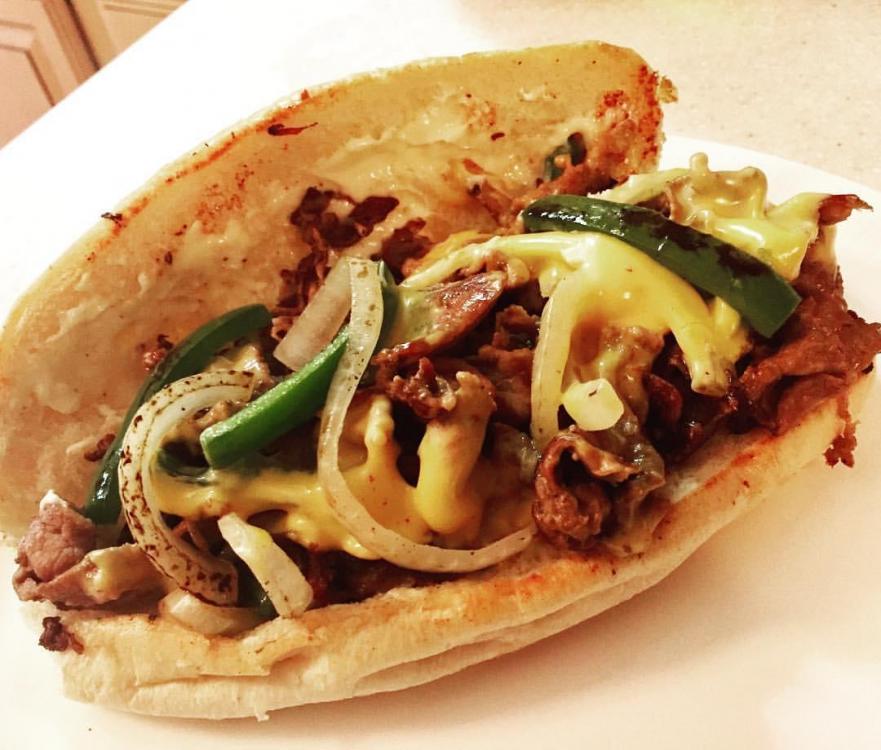-
Posts
1,807 -
Joined
-
Last visited
Content Type
Profiles
Forums
Store
Help Articles
Everything posted by btbyrd
-
I think the Yoshihiro descriptions on Amazon are inaccurate. The copy for the Hi-Soft boards on the Yoshihiro website says not to put them in the dishwasher. Everything I've seen says not to put them in the dishwasher. PVA is essentially wood glue; it's a soft polymer, and sticking it in a boiling (or close to boiling) hot environment doesn't seem like a good idea to me. Korin says that they shouldn't be exposed to temps over 70C to reduce the chance of warping or softening. Sounds right. Yoshihiro also claims (on Amazon, but not their own website) that their Hi-Soft boards are NSF approved, but they don't have the NSF seal/logo on the product packaging the way that, say, Sani-Tuff rubber boards do. I'm not saying that the boards aren't NSF approved, but... if I had to put money on it, I'd go by the description on the Yoshihiro website (which doesn't mention NSF and says that PVA boards aren't dishwasher safe) rather than on Amazon.
-
The Yoshihiro Hi Soft ones are essentially the same as the Korin ones, but are pricier and have a built in handle. If you're going to get a larger one, the handle might be worth the price. They get heavy. Attached are some pics of the "small" Korin Hi Soft board, portioning some sockeye. It's biggish.
-
My current favorite is a Hi-Soft board I purchased from Korin. They're made from polyvinyl acetate. It is very forgiving on edges and allows you to mow through big piles of whatever and keep your knife sharp. My favorite thing to cut is thin ribbons of napa or red cabbage with a razor-sharp Global G17 (which has a pretty burly 11" blade). I can just SHRED through the cabbage paper thin, banging the blade up and down. It's a real pleasure. All my fish goes on it too. I got the small size on Amazon, where it's not currently listed as being available. They have a bunch of sizes, but even the "small" one is on the large size for home use. There are two smaller sizes, and I'm thinking about picking one up. They're 15% off at the moment. One possible bad thing is that they're quite thick and heavy by ordinary consumer-grade, synthetic cutting board standards.
-
What induction unit are you using? The cheap ones don't manage heat very well. They're also not good at seasoning cast iron or carbon steel, since these don't conduct heat well and form a concentrated hot spot over the induction coil (which is much smaller than most pans). Edit: I saw the brand you're using, and would expect it to perform well. My comments mostly apply to portable induction burners. I'd be interested in hearing more from this those with full cooktops.
-
The sugar/salt dry brine and rinse technique is nice because not only does it pull out moisture and firm up the texture, the salt and sugar help bind the albumen so you won't have problems with gross white fish ooze if you cook it.
-
I do this every time I prepare fish.
-
Like others have said... it's a basic stock, so use it everywhere you might think it'd be useful. Poach fish or vegetables in it. Use it as a soup base (udon, ramen, etc...). Use it to flavor grains. Use it in sauces. Put some in a saucepan and steam some shellfish open in it. I like David Chang's appropriation of "dashi" where he uses kombu with things that aren't bonito to create new flavors. Most famous is his "Bacon Dashi," which is delicious. I also like to make a version with smoked country ham hocks. Kombu-infused country ham hock broth is the bizness. Chang also uses various vegetables to create things like "carrot dashi" that he uses to poach carrots in. Morimoto uses dashi a lot. Watching some of his battles on Iron Chef (or checking out his cookbook, which is great) is a great place to pick up some ideas.
-
I recently received a small and regular Kunz spoon, both in perforated and "normal" versions. For size comparison, here they are alongside the small, medium, and large Ruhlman offset spoons (and the Badass Egg Spoon). If I had it to do all over again, I probably wouldn't get the small, non-perforated spoon since it's remarkably close in size and shape to the "soup spoons" in my normal place setting. To be fair, I hate eating out of those spoons, as they're too big to eat from normally. All I use them for is cooking, and they're great for that purpose. (I never eat from them; I use the Ruhlman offset soup spoons instead.) Anyway, here's the small Kunz spoon along side my too-big soup spoon and a regular spoon from the same set. I'm sure I'll use it a lot regardless, but it's not as unique a tool as the perforated version. I'd gladly swap out all my crappy soup spoons for Kunz spoons... but that's a pricey proposition.
-
Mine won't be here until Tuesday... silly holiday weekend. I'll post a picture of these alongside the Ruhlman spoons once they get here. I will say that the perforated BAE spoon from Ruhlman is quite large, and is more like a serving spoon (or something you'd cook with) than an oversized "regular" spoon.
-
I keep thinking to myself, "If only it were $350...". I'm glad these are going to be made, but they're a bit above my pay grade for the amount of use I'd get out of it. But if I were super-paid, or if I ran a bar program, I'd totally get one. Or three (in the case of the bar program).
-
You have to set the oven to higher than the oil's smoke point, so 350 won't work for most oils.
-
JB Prince is offering free shipping on orders over $49 (coupon code FREESHIP17). I picked up a set of Kunz spoons and some goodies from Cocktail Kingdom (including one of the large Yarai mixing glasses for stirred cocktails).
-
Drying oils will eventually harden if exposed to air at room temperature. They are super-unsaturated and therefore oxidize, crosslink, and go rancid quickly. This gives them some interesting functional properties that make them good bases for oil pants and varnishes. Some people think these properties also make them magical seasoning oils for cast iron and carbon steel. And they may be marginally better than alternatives -- maybe. But I've not personally found them to offer any advantages and wouldn't recommend anyone bother to spend the effort (or money) to track them down. Especially since they can leve a brittle layer of seasoning that is liable to flake off.
-
Have you checked the smoke point of flax oil lately? I use refined "extra light" olive oil as my neutral cooking oil, and that's what I use to season with (though I'll use EVOO sometimes if that's what's nearby). The smoke point of extra light olive oil is around 470F. I don't think that an oil's smoke point is a reliable indicator of its ability to season pans (provided that you're not using something like avocado oil that has a smoke point higher than your oven might go).
-
That product is more snake oil than anything else. Flax seed oil -- even magical organic, cold-pressed oil -- has a fatty acid profile that makes it prone to oxidation and rancidity. That's why the higher quality flax oils are in the refrigerated section. "Will never go rancid"? Ha! It'll go rancid before pretty much any oil in your kitchen. Flax is already an expensive uni-tasking oil, but the pricetag on this oil is astronomical. $15 for four ounces? Get out of here. The product description claims that flax is "the only drying oil that's edible." This is patently false. Walnut oil is another drying oil, and has a fatty acid composition similar to flax. And it actually tastes good. If you buy into the "gotta use a drying oil to season pans" mumbo jumbo, use walnut instead. When I last seasoned my pans, I was making salads dressed with walnut oil vinaigrettes every day for lunch for like a month. It was kinda nice, actually.
-
I have successfully used lard, walnut oil, and olive oil on my Matfer.
-
My suggestion is not to stress about it and not to buy a special, expensive bottle of uni-tasking oil that you have to source from a "health food" store and sit taking up space in your refrigerator. Especially if it leaves a brittle layer of seasoning that is liable to chip. If you want to use a "drying oil" with a similar fatty acid profile to flaxseed oil that actually has a culinary purpose and tastes delicious, use walnut oil. I mostly use "light" olive oil, but tend to use whatever I have on hand.
-
On a related note, people stress way too hard about what oil to use to season cast iron and carbon steel. Way too hard.
-
I've heard that flaxseed oil leaves a brittle seasoning that's liable to flake off. I never use the stuff (though I did use it for the initial round of seasoning on my first Darto pans). It's an expensive product that has no other use in my kitchen. And it's prone to go rancid. I don't know where the lore about using flax came from (though I suspect Sheryl Canter plays a big part in the story) but it's not worth tracking down and paying for in my experience.
-
They're a mix of green bells and jalapenos. I would have used pablanos, but the ones at the store were quite sad. I actually like green bells though, and prefer them to other bells for most applications. Yellow, orange, and red bells tend to be sweeter and lose all their... pepperiness. I almost regard them more as fruit than vegetable (even though they are fruit, botanically speaking). Reds and yellows are great for soup, or for adding some visual pop to a stir fry... but when I want something peppery without heat, pablanos are my top choice, and then green bells. (Unless I'm stuffing them, in which case, the shape of the bells wins out.)
-
Broke out the carbon steel and put a fierce sear down on some beef, peppers, and onions. My cheesesteak game is on point:
-
TLDR: There's actually no warping and the pans are totally fine. If you wanted to get them, get them. They're great pans and I'd buy them again. Okay, so... Upon investigation, it turns out that the pan isn't warped at all, but that all of my Dartos have a slightly rounded bottom so that they do not sit completely flat on a flattop. I'd never noticed this on my old gas burners because of the way the grates on those hold the pan. I moved about six months ago and hadn't noticed the wobble until the other night when, after a long night of cooking, a couple bottles of wine, and doing a big sinkful of dishes, I did a round of seasoning on my No. 27 (which hadn't been reseasoned since the move). I also did a round of seasoning of my 12" Matfer carbon steel pan at the same time. As it turns out, my No. 27. (and 23, 20, and 15) has a slightly convex bottom. This is only true of the bottom of the pan; the interior is completely even and flat. The curve on the exterior is very subtle -- so subtle that I hadn't noticed it on pans apart from the 27 until just now. The curve is least noticeable on the No. 15 and becomes slightly more noticeable as the pans get bigger... so it's most noticeable on the 27. But still, it's pretty subtle. I'll add that the curve isn't getting worse. I just noticed it less in the past because for the first 8 months that I had the Dartos, I was cooking on grates rather than a flattop. Now that I'm on a flat surface all the time, it seemed like it'd gotten worse. Really, it was just that my heating surface had gotten flatter. In practice, the curve doesn't impact the performance of the pans (at least in my experience with gas, electric, and induction) and my drunken complaint about warping was totally off the mark. It turns out that the pans don't sit totally flat and I didn't notice until I seasoned one alongside a Matfer (which sits completely flat). At any rate, I still love these pans and would buy them all again. The Matfer pans are great too, but the Dartos look and feel like something special whereas most other brands just seem like "a good, solid pan." Don't let my hastily composed, drunken offhand comment dissuade you.
-
EDIT: This post is actually not accurate and was written hastily. There is actually no warping at all, just a slightly rounded bottom on all of my Dartos that I'd never noticed before. My No. 27 came slightly warped, but it's gotten more warped recently. It wouldn't bother me if I still had a gas range, but now that I cook on a flat electric cooktop (or induction HOB), the wobble is annoying. Grr.
-

Confused about how beef is graded? Here is Canada's answer.
btbyrd replied to a topic in Kitchen Consumer
Apparently, more than 97% of graded Canadian beef carcasses score as one of the "A" grades. Sounds like a bit of a low bar. Luckily, the vague adjectives they use to categorize the various A-grades is of zero help. But that shouldn't matter so long as you simply assume that "small" marbling is better than "slight," which is better than "trace." LOOK AT THAT SMALL MARBLING! IT'S SO SMALL! I MUST HAVE IT! -
Commercial mayonnaise is perfectly safe to leave out at room temperature. Its water content and pH are low enough to inhibit the growth of pathogenic bacteria. In fact, higher concentrations of mayonnaise in meat salads have been shown to retard rather than promote the growth of pathogenic bacteria.




